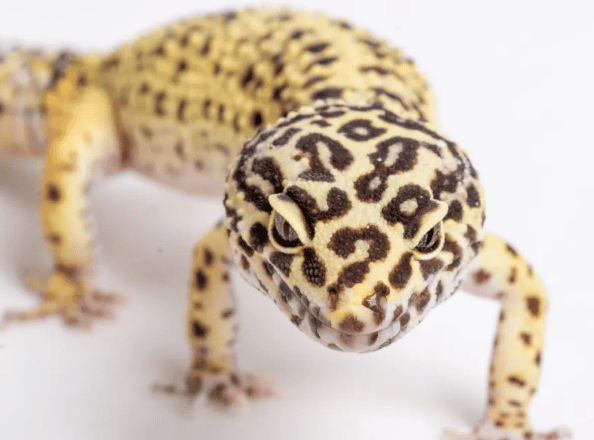The leopard gecko (Eublepharis macularias) is one of the most well-known and popular reptiles in the world.
But when many people think they know 100% about them, there is a question that may stump almost everyone who opens this article:
The larvae of leopard geckos To adulthood
Why do we experience such drastic color changes?

The name "leopard pattern" of leopard geckos comes from their adult color: The primary color leopard gecko is rich in dark spots and markings, and depending on the individual, you can also see some more or less obvious horizontal bands. Coupled with the khaki background, in an era when adjectives are scarce, it is indeed easy to associate it with "leopard print".
However, everyone who sees a leopard gecko larvae (with striped genes) for the first time will have a thought in their mind: Is this thing the same species as the adult?

One-month-old wild leopard print
Yes, leopard print The color scheme of larval geckos is completely different from that of adults: larvae of primary leopard geckos are usually much darker in color and have far fewer spots than adults. Instead, there are well-defined black/purple-yellow horizontal bands, which look very contrasting. No matter how you look at it, this color scheme is not suitable for living outside. It simply has "come and eat me" written all over it - this is so abnormal!
As they grow, the dark areas dissolve and blend into the spotted pattern, and the obvious white lines on the head and neck usually fade away. It only takes more than four months for you to witness this dramatic color change, and the leopard gecko at this time is completely different from when it was a baby.

A 3-month-old wild leopard gecko
Although this form The biological function of the change has not yet been determined, but senior research experts have drawn a relatively reliable inference: the color matching of larvae is not to warn natural enemies, but to prevent being accidentally eaten by their parents
Adult tall yellow leopard The tattooed gecko
There are no traces of horizontal stripes at all
Surprised? In fact, this inference can also be found in other geckos. In the third episode of my documentary series [Tropical Legends] Landau Reptile Park, I mentioned that Madagascar’s marble day geckos will also experience drastic changes as they grow. Research on this species shows that the main purpose of the markings of the small marble gecko is to warn parents "Don't eat me, I am your cub"
< img src="/zb_users/upload/2024/04/3cc423e1d498e1.png" title="The mystery of the color change of the leopard gecko larvae" alt="The mystery of the color change of the leopard gecko larvae" width="580" height= "321"/>
The two reptiles have many commonalities, and knowledge of species that "cannot be kept" would also be helpful
Is this purpose reasonable for leopard geckos?
Let’s start with actual experience. At the beginning of this century, Ron Tremper, a well-known American breeder, and Philippe de Vosjoli, a well-known gecko expert, published relevant experiences: when the parents are nutritionally deficient, if the newborn larvae without stripes are allowed to live together with the parents, there is a high probability that predation will be triggered immediately. Behavior. As early as the late 1990s, German snake expert Rolf Kreutz also published the same observation experience.
All practical results point to one reason: the clearly defined horizontal stripes of larvae inhibit the feeding of adult leopard geckos.

Leopard geckos with developed night vision
But this phenomenon is Is it really true in the wild?
Since the field observation records of leopard geckos are still very scarce, I can only speculate based on the existing data: the larvae of leopard geckos living in areas with large day and night temperature differences may not look like The East Asian cave tiger (Goniurosaurus) is active at night. They may spend much less time outside than adults, so the probability of using this markings for predators is not as high as that of cave tigers.
Combining the fact that leopard gecko larvae need a higher humidity environment than adults can also help verify this speculation - larvae should stay in an environment with higher humidity and stable temperature for longer than adults. This environment is often where adult leopard geckos will visit. Therefore, in these gaps, young leopards may encounter their elders more easily than other natural enemies.
Will you be eaten when you meet an elder?
Please pay attention to the prerequisites put forward by the predecessors who have done experiments in the previous article - only adult leopards that lack nutrition will prey on striped larvae. Wild leopard geckos are much smaller than those in captivity. Wild leopards that are hungry for a long time will indeed stuff everything into their mouths. It can be explained by assuming a protective mechanism for the problem - of course, this speculation is still at the speculative stage, and there has been no special scientific experiment to support it. But this line of speculation is indeed the most reliable one among many guesses.
Seeing this, you who are good at thinking may have new ideas: Since horizontal stripes are a protective mechanism for species larvae, does that mean that the social behavior of wild leopard geckos is more common than imagined? Will they develop specialized chemical signals to aid communication? Could this feeding inhibition strategy be generalized to other geckos or lizards? etc. ... If you are engaged in behavioral science, wildlife conservation and other majors, you will definitely think of more new questions.
But this inference is 20 years old, and these questions still have no answers.

So, when you think you know enough about a species, maybe it's just the superficial level that's popularized That’s all. There are many unresolved problems that have been ignored by previous generations, and there are often loopholes in the information we receive. But if you want to gain eternal pleasure from them, please be sure to keep asking yourself "why"

 扫一扫微信交流
扫一扫微信交流
发布评论